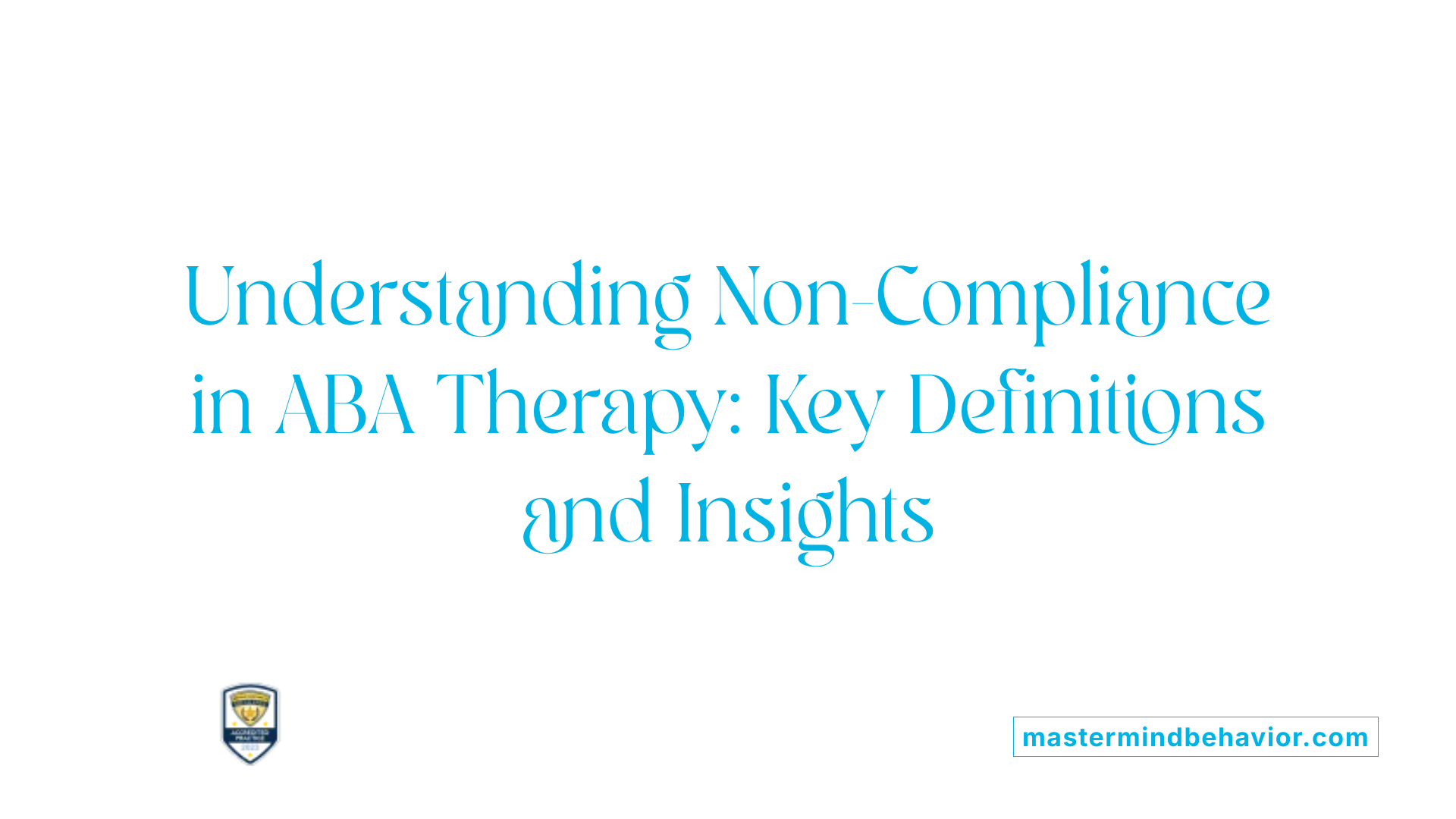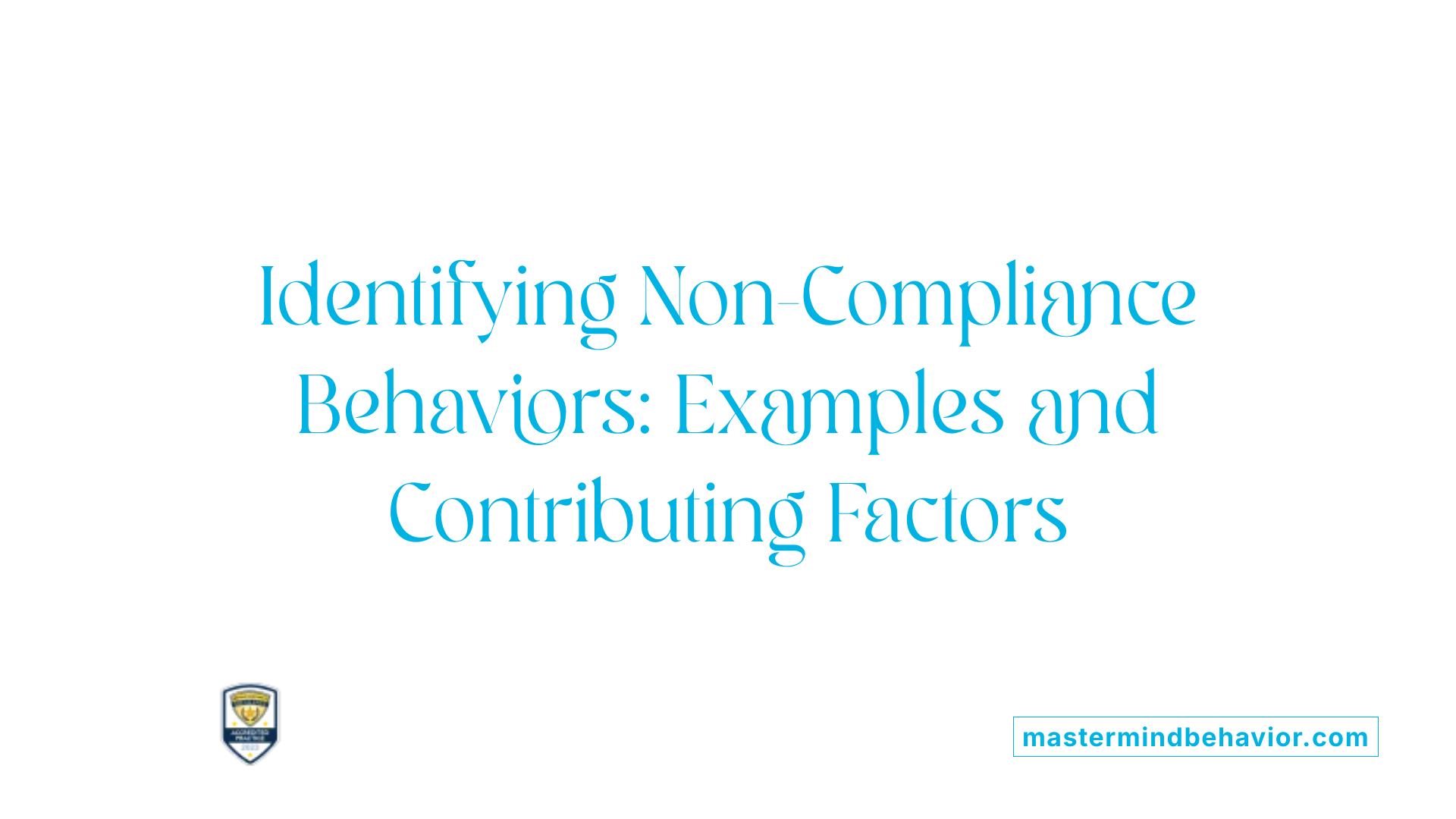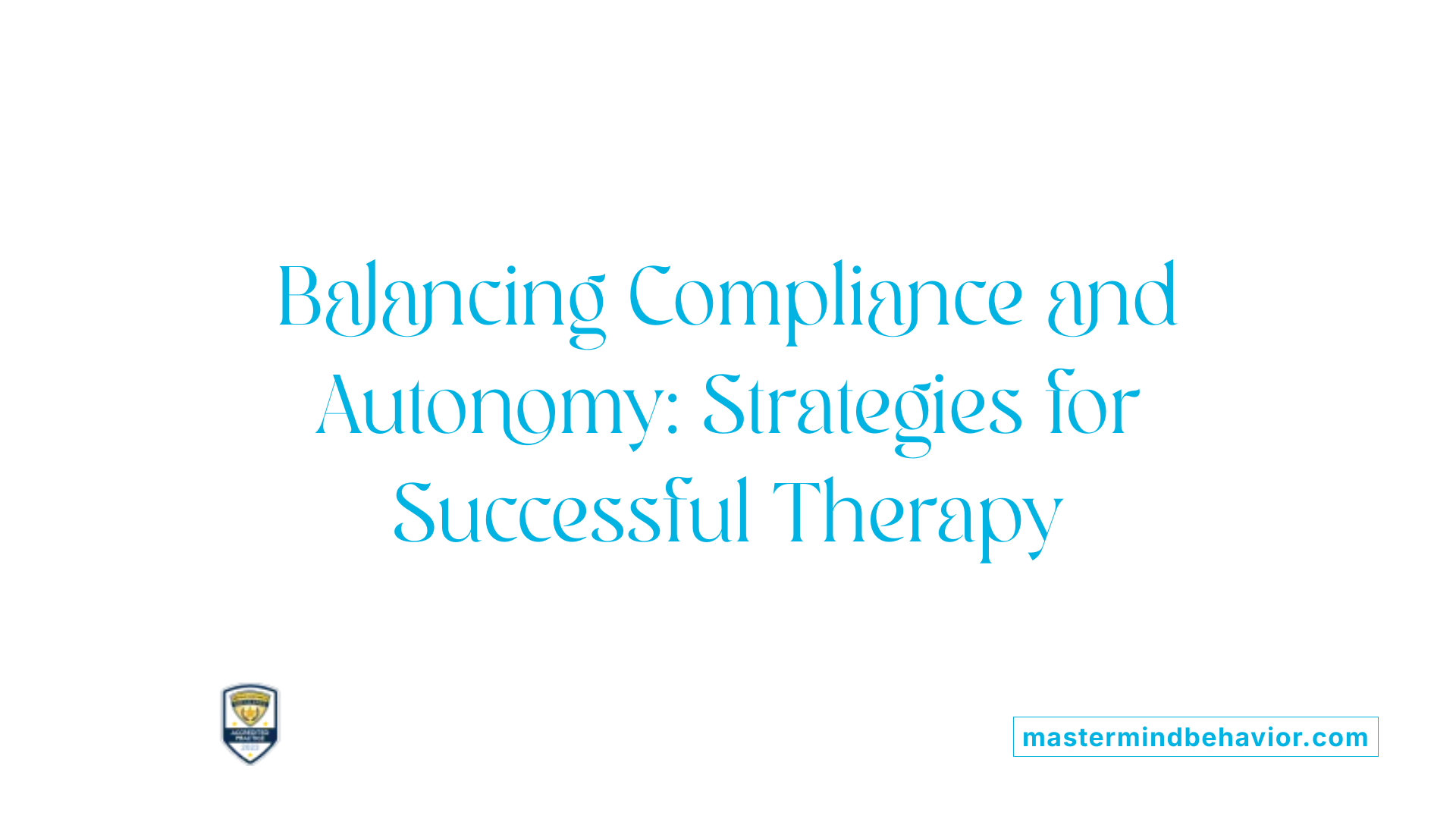How to Address Non-Compliance Using ABA Therapy

Understanding Non-Compliance in ABA Therapy
Non-compliance can present significant challenges for children undergoing Applied Behavior Analysis (ABA) therapy, often posing obstacles in their therapeutic progress and daily interactions. For children with Autism Spectrum Disorder (ASD), non-compliance can manifest as ignoring instructions, exhibiting refusals, or demonstrating defiant behaviors. Addressing this issue within ABA therapy requires a nuanced approach that incorporates evidence-based methods, respects child autonomy, and promotes effective communication strategies. Through a deeper understanding of non-compliance, therapists, parents, and caregivers can better support children's development and advocacy skills.
Defining Non-Compliance in ABA Therapy

How is non-compliance defined in the context of ABA therapy?
Non-compliance within ABA therapy refers to instances when a child either physically or verbally refuses to follow an instruction or complete a designated task. It's important to highlight that non-compliance does not fall under the behavior defined by the Dead Man test, which states if a dead man can perform it, it isn’t a behavior. Instead, non-compliance is operationally defined as a refusal to adhere to a directive within an established timeframe. This includes behaviors like verbal protests, ignoring instructions, or physically resisting compliance.
Reasons behind non-compliance
Understanding the motivations behind non-compliance is critical. Non-compliance can often stem from:
- Escape from demands: The child may attempt to avoid a task they find unpleasant.
- Attention-seeking behavior: Children may refuse to comply to gain attention, even if it is negative.
- Medical issues or developmental stages: These can affect a child’s ability to understand or follow through with tasks.
Therapists must assess these underlying factors to tailor effective strategies accordingly.
Role of reinforcement
Positive reinforcement plays a pivotal role in managing non-compliance. By consistently reinforcing compliant behavior with appropriate rewards—like praise or tangible incentives—therapists can increase the likelihood that a child will follow future directives. Ensuring that tasks are age-appropriate and reasonable also aids in enhancing compliance, as unrealistic demands can lead to refusals. By focusing on these strategies, the therapeutic environment can evolve into one that promotes cooperation rather than mere compliance.
Recognizing Non-Compliance Behaviors

What are some examples of non-compliance behaviors?
Non-compliance in children can manifest in various ways. Here are a few examples:
- Ignoring directives: Children may simply refuse to acknowledge instructions given by parents or teachers.
- Verbal refusal: This includes outright saying "no" when asked to follow a command or suggestion.
- Temper outbursts: Often, children may react with anger, frustration, or physical aggression when prompted to do something they dislike.
These behaviors are frequently observed in children, especially during interactions in chaotic environments or when they are testing boundaries.
What contributes to non-compliance?
Several factors can contribute to non-compliance in children. These include:
- Low parental warmth: A lack of emotional support from caregivers may lead to rebellion against authority.
- Inconsistent discipline: Inconsistent responses to behaviors can confuse children, leading to non-compliance as they test limits.
- Environmental stressors: Stressful situations at home or school can heighten non-compliant behaviors as children struggle to cope.
Understanding these contributing factors is crucial for developing effective interventions to manage non-compliance.
How does non-compliance impact families and therapy?
The presence of non-compliance can significantly affect family dynamics and therapeutic outcomes.
- Emotional strain: Persistent non-compliance can create frustration among parents and caregivers, making interactions tense.
- Therapeutic challenges: In therapy settings, non-compliance complicates the implementation of interventions, hindering progress.
- Relationship building: Successful goal achievement in therapy relies on compliance, so non-compliant behaviors can damage trust between the therapist and child, making it difficult to foster positive change.
By recognizing these behaviors and their impacts, families and therapists can collaboratively strategize to promote better compliance and emotional health.
Effective Interventions for Managing Non-Compliance

What effective interventions exist for managing non-compliance in ABA therapy?
Effective interventions for managing non-compliance in ABA therapy focus on fostering a supportive environment through positive reinforcement and clear communication. Instead of using punitive measures, it's vital to maintain positive interactions. Here are several actionable strategies:
- Clear Instructions: Provide single, simple, and clear directives to enhance understanding. Avoid repeating instructions that might incentivize non-compliance.
- Positive Reinforcement: Regularly acknowledge and reward compliant behaviors, utilizing verbal praise, tokens, or tangible rewards. This approach not only encourages desirable behavior but also enhances the child’s motivation to follow through on tasks.
- Behavior Guidance: Teach children self-regulation skills which can include delaying gratification or utilizing reminders to think before acting. This helps children manage impulses that may lead to non-compliance.
How does the role of positive reinforcement fit in?
Positive reinforcement is essential in encouraging compliance. By providing appropriate feedback and rewards for following directions or completing tasks, caregivers can significantly increase compliant behavior. Structured reward systems help children feel appreciated for their efforts, further motivating them to engage positively in daily activities. Consistent praise, particularly in conjunction with task completion, strengthens the connection between compliant behavior and positive outcomes.
Why is tailoring interventions important?
Tailoring interventions to meet each child's unique needs is crucial for promoting compliance effectively. Understanding the underlying causes of non-compliance—whether rooted in comprehension challenges or developmental stages—allows therapists to adjust their methods accordingly. Individualized interventions ensure that each child receives the specific support required to thrive. If difficulties persist, seeking help from skilled professionals, such as psychologists or counselors, can provide additional strategies and insights for managing non-compliance longer-term.
The Role of Guided Compliance

What are the benefits of guided compliance in ABA therapy?
Guided compliance in ABA therapy offers numerous advantages, particularly for children with autism. This approach systematically employs prompts to foster compliance among children, effectively aiding them in learning new skills while minimizing off-task behaviors. Through the proper implementation of guided compliance, caregivers and therapists can significantly improve the overall effectiveness of their interventions.
One notable benefit is the promotion of independence. By gradually fading physical prompts, children are encouraged to develop autonomy in completing tasks. This reduces frustration and enhances their overall experience during therapy sessions, as they learn how to navigate and engage with demands more confidently.
Additionally, caregivers who receive training in guided compliance are better equipped to implement these strategies, enhancing their skills and improving the child's compliance rates.
The outcome of effective guided compliance goes beyond just following directives; it leads to better quality of life, and improved communication and social skills for children. This method respects the child's voice and enhances the therapeutic environment, making learning not only effective but also enjoyable.
Increasing Compliance with Structured Approaches
How can compliance be increased in ABA therapy?
To increase compliance in ABA therapy, establishing a structured routine is vital. Consistency helps children feel secure and more in control of their environment. This stability can significantly lessen anxiety, paving the way for increased cooperation.
Building rapport with the child is equally important. When children trust their therapists, they tend to be more receptive to instructions. Starting therapy sessions with preferred activities can enhance this connection and foster motivation.
Providing clear and concise instructions can also dramatically enhance compliance. Using visual supports such as schedules, charts, and timers can clarify what is expected of the child. This approach allows them to visualize their tasks, enhancing understanding.
Offering choices is another effective strategy. Empowering children by allowing them to make small decisions during tasks can lessen resistance. Additionally, incorporating transition warnings prepares children for upcoming changes, which can lead to smoother transitions and better compliance.
Overall, a combination of structured routines, rapport-building, clear communication, and empowerment through choice lays a solid foundation for increasing compliance in ABA therapy.
Balancing Compliance with Autonomy

Importance of Respecting Autonomy
In ABA therapy, recognizing a child's autonomy is fundamental. Non-compliance can be an important form of self-advocacy, allowing children to express their needs and preferences. Instead of simply enforcing compliance, focusing on cooperation respects individual choices and promotes healthier interactions. This approach nurtures a sense of agency, empowering children to communicate their needs effectively and understand their rights.
Challenges in Compliance-Focused Interventions
Compliance-centric strategies can sometimes undermine a child's autonomy. When interventions overly emphasize obedience, children may feel their voices are silenced, leading to frustration and resistance. Addressing contradictions between promoting compliance and respecting a child's autonomy can create tension in therapy settings. To mitigate this, therapists must be attuned to the balance between guiding compliance and allowing children the freedom to express dissenting opinions.
Strategies for Balancing Compliance and Self-Advocacy
Implementing an integrated compliance management system (CMS) can help reconcile these two goals. Engaging clients and their families in treatment planning fosters ownership over therapy processes while maintaining necessary structure. Therapists can use ongoing feedback to adjust approaches, ensuring that interventions prioritize individual needs. Here are strategies to balance both:
- Involve Families: Collaboration with families in treatment planning can enhance respect for autonomy.
- Transparency in Goals: Clearly outline therapy goals to create a shared understanding.
- Foster Communication: Encourage open dialogue about the importance of both compliance and personal choice.
By embracing these strategies, therapy can be a cooperative journey rather than a strict compliance endeavor, enhancing both effectiveness and empowerment.
The Consequences of Non-Compliance
What are the consequences of non-compliance in ABA therapy?
Non-compliance in ABA therapy can have significant repercussions. The foremost concern is its potential to hinder progress in skill acquisition. When a child refuses to follow directions, the opportunity for learning and developing new skills diminishes. This often leads to an increase in maladaptive behaviors, as children may resort to negative actions when they feel their needs or wants are unmet.
Moreover, the therapeutic relationship between the client and the staff can suffer due to non-compliance. A strong bond is crucial for effective therapy, and non-compliant behavior can undermine trust and predictability, which are essential for a secure learning environment. Clients may feel anxious or confused, further complicating their engagement in therapy sessions.
Additionally, accurate data collection is vital in ABA therapy, as it informs treatment decisions. Non-compliance can skew this data, making it difficult to assess a child's progress accurately and resulting in inappropriate treatment adjustments. Understanding the underlying reasons for non-compliance—whether they stem from escape behaviors, attention-seeking motives, or communication barriers—is crucial in this context.
In summary, the consequences of non-compliance are profound, impacting therapy progress, weakening therapeutic relationships, and distorting data collection. By implementing proactive strategies, such as consistent reinforcement and tailored interventions, therapists can address non-compliance effectively and enhance overall therapeutic outcomes.
Proactive Communication Strategies
Effective communication methods
Effective communication is vital in addressing non-compliance in children, especially those with autism. Strategies such as avoiding yes or no questions, providing clear, one-time instructions, and offering choices can empower children, making them feel more in control of their environment.
Role of proactive approaches
Proactive approaches focus on anticipating non-compliance by initiating discussions about non-preferred tasks ahead of time. Involving children in these discussions fosters engagement, making them more willing to comply when the time comes.
Use of positive reinforcement
Consistent and specific praise for compliance plays a crucial role in encouraging positive behavior. Tangible rewards can further motivate children, ensuring that compliance is recognized and reinforced, ultimately leading to successful task completion.
Moving Forward with Confidence
Addressing non-compliance within the framework of ABA therapy involves nuanced understanding, strategic interventions, and a commitment to balancing compliance with respect for individual autonomy. By equipping children with the tools for self-advocacy and effective communication, stakeholders of ABA therapy can empower them to navigate their environments confidently. As research and practice continue to evolve, ensuring that interventions are individualized and evidence-based will remain critical to enhancing both compliance and overall quality of life for children undergoing ABA therapy.
References
- Reactive Strategies for Noncompliance in ABA Therapy
- Addressing Non-Compliance in ABA Therapy - Powerback Pediatrics
- Rethinking Non-Compliance as a Skill and Promoting Self-Advocacy
- AN EVALUATION OF EVIDENCE-BASED INTERVENTIONS TO ...
- [PDF] Rethinking Non-Compliance as a Skill and Promoting Self-Advocacy
- Compliance Training: Teach Cooperation While Preserving ...
- Can ABA Therapy Help Manage Challenging Behaviors in Autism?
- Noncompliance is a Skill, Not a “Problem Behavior”
Recent articles

The Importance of Cultural Sensitivity in Behavior Therapy Programs
Enhancing Therapeutic Outcomes Through Cultural Awareness

The role of humor in reducing stress for caregivers
Laughter as a Lifeline: How Humor Eases Caregiver Stress

The Role of Technology in Supporting ABA Therapy Services
Transforming Autism Support: The Impact of Innovative Technologies in ABA Therapy

The role of data collection in ABA therapy
Harnessing Data: The Backbone of Effective ABA Therapy

The Role of ABA Therapy in Managing Anxiety in Children with Autism
Harnessing ABA for Enhanced Anxiety Management in Autism

The Benefits of Consistency in In-Home ABA Therapy Services
Enhancing Autism Support Through Routine and Reliability



